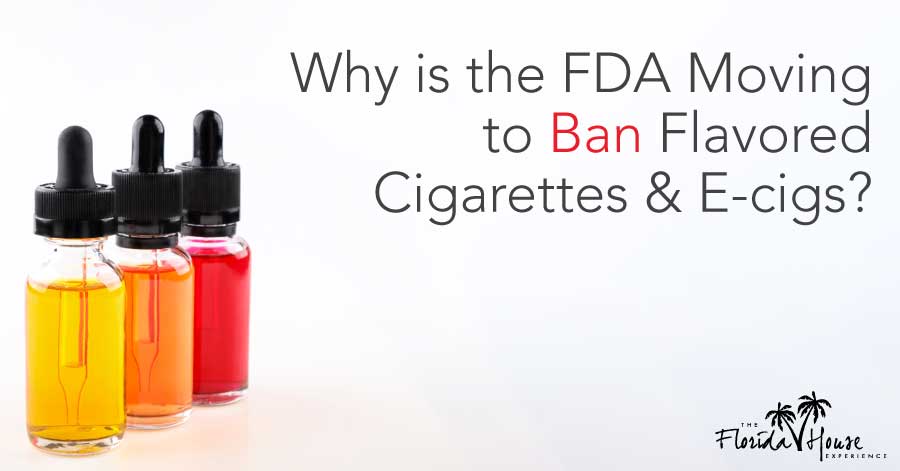
If you are over 35, you probably don’t know much about electronic cigarettes, or “e-cigs”. Millennials call smoking e-cigs and e-hookahs “vaping”, a term describing the way an e-cig heats flavored liquids containing nicotine to generate vapor that is then inhaled.
Nicotine used to make e-cig liquids is extracted from traditional cigarette tobacco and combined with colorings, chemicals, flavorings and propylene glycol. Found in many processed foods, medications and cosmetics, propylene glycol helps the body absorb certain chemicals more efficiently. Manufacturers of e-cig fluids add propylene glycol to nicotine-based solutions to enhance the smoothness and taste of the vapor.
What is the FDA Doing to Stop the E-Cig Craze?
 After months of speculation about action the FDA was going to take, some reports going as far as saying the FDA would out-right ban e-cigarettes, they unveiled their plan. On November 15, 2018, the Food and Drug Administration (FDA) announced a series of actions intended to reduce the number of young people who are smoking flavored cigarettes and e-cigs. Some things the FDA plan to implement include:
After months of speculation about action the FDA was going to take, some reports going as far as saying the FDA would out-right ban e-cigarettes, they unveiled their plan. On November 15, 2018, the Food and Drug Administration (FDA) announced a series of actions intended to reduce the number of young people who are smoking flavored cigarettes and e-cigs. Some things the FDA plan to implement include:
- Increasing enforcement of regulatory laws against retailers selling electronic cigarette products to people under 18 years of age;
- Working with the Federal Trade Commission (FTC) to target manufacturers of e-liquids who use misleading imagery (lollipops and juice boxes, for example) that deliberately appeals to older teenagers and young adults;
- Working with Ebay to eliminate listings for e-cigarettes and flavored cigarettes.
In addition, the FDA says it wants to ban flavored cigars, menthol cigarettes and restrict sales of e-cigs online. However, the FDA does not plan to completely ban vape flavors being sold in brick-and-mortar stores.
A ban on menthol cigarettes requires completely new regulations which may take years to pass. But the FDA intends on pursuing such regulation because research clearly indicates menthol cigarettes are difficult to quit and more attractive to younger people than non-menthol cigarettes.
Statistics on E-cig and Flavored Cigarette Use in the U.S.
 The US e-cig market expanded 40% in 2017 and generated over $1 billion in sales;
The US e-cig market expanded 40% in 2017 and generated over $1 billion in sales;- High schoolers using vaping devices has increased nearly 80% since 2017;
- The most popular vaping products are made by Juul, a rapidly growing e-cig company offering exotic flavors and vaping devices that conveniently burn “pods” instead of fluids;
- A CDC study recently found that the majority of adults resorting to smoking e-cigs while trying to stop smoking traditional cigarettes ended up using BOTH products;
- Nearly 5% of all U.S. middle schoolers (ages 11 to 14) report smoking e-cigs on a regular basis;
- A University of Michigan study discovered that young people using e-cigs are four times more likely to begin smoking traditional cigarettes within one year.
Dangers of Using E-cigarettes
In addition to nicotine, e-cig aerosol contains heavy metals, volatile organic compounds (VOCs) and other possibly carcinogenic substances meant to enhance nicotine activity in the brain. A 2018 article in Pediatrics examined urine samples of 16 year olds using e-cigs and found excessively high amounts of cancer-causing VOCs like propylene oxide, crotonaldehyde and benzene in their urine. Authors of the study state that although e-cig vapor is slightly less dangerous than tobacco smoke, the combination of nicotine and VOCs inhaled by young people carries a genuine risk for development of cancer and other diseases as they age.
Why Does the FDA Want to Restrict Sales of Menthol Cigarettes?
Contrary to a long-standing belief that menthol cigarettes are less harmful than non-flavored cigarettes, menthol cigarettes pose a definite health risk higher than the risk seen with non-flavored cigarettes. Researchers have found that the mint-flavored coolness of menthol cigarette smoke covers up the harshness of tobacco smoke. Consequently, people tend to smoke more menthol cigarettes than non-menthol cigarettes.






